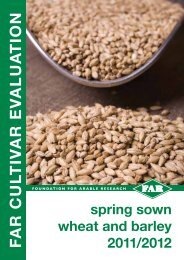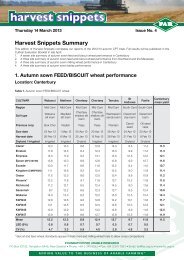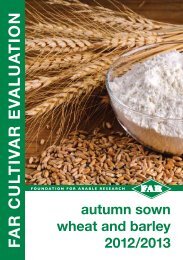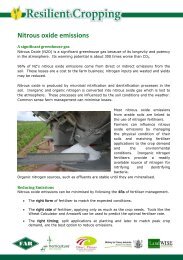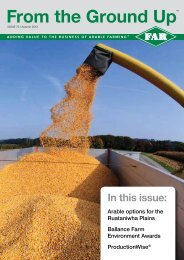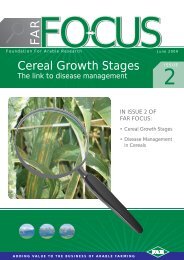Drainage
Drainage
Drainage
Create successful ePaper yourself
Turn your PDF publications into a flip-book with our unique Google optimized e-Paper software.
<strong>Drainage</strong><br />
<strong>Drainage</strong> is essential<br />
Good drainage systems quickly remove excess surface and sub-surface water from the paddock.<br />
An effective drainage system will remove excess soil water within 24 hours of the rainfall event.<br />
A good time to assess the needs on your farm is after a heavy rain event when problems with<br />
ponding and runoff are easy to see.<br />
There are a number of options available to improve drainage, including:<br />
<br />
<br />
<br />
re-shaping the layout or contour of the paddock<br />
improving surface drainage to remove surface water quickly from cropped areas<br />
installing subsurface drainage to remove water from saturated soils by downward flow.<br />
Planning<br />
A farm drainage system requires careful planning to optimise the capital expenditure. A<br />
successful scheme will considers these factors:<br />
1. What is causing the water-logging problem? Is it from surface or subsurface water or<br />
both? Where is the water coming from?<br />
2. What is the frequency and duration of water-logging and how big is the affected area? Is<br />
remediation a priority for on-going profitability?<br />
3. Is there sufficient outfall available? Water needs to be drained away to somewhere else,<br />
preferably by gravitational flow, otherwise it becomes a costly exercise involving pumps.<br />
Are the outfall drains well maintained and deep enough to remove water quickly?<br />
4. What are the likely benefits? Will the cost of the drainage scheme be returned through<br />
increased productivity and how long will it take?<br />
5. Which areas should be drained first? Efficiency and cost savings can be gained by<br />
considering the drainage plan for the whole farm and working out which part should be<br />
tackled first.<br />
6. What type of drainage system is required?<br />
7. Do I need assistance to develop a plan?<br />
Reshaping<br />
Other options include ensuring surface contour<br />
allows effective water movement. Precision land<br />
levelling is useful in removing depressions in<br />
paddocks where ponding is a problem. Bunded<br />
headlands can prevent water flowing into the crop<br />
and cultivation methods such as furrow diking<br />
reduce run-off by slowing the water movement<br />
along wheel tracks.<br />
Precision levelling using high accuracy GPS
Title<br />
Surface drains<br />
Surface drains are useful for intercepting run-off from neighbouring higher areas and draining<br />
surface water off the land quickly. They also collect water from sub-surface drains. Surface<br />
drains include ditches, drains and grassed waterways. They must be regularly maintained to<br />
keep them flowing and may be a hazard for machinery and animals. Care must be taken to<br />
prevent bank erosion and damage from stock access.<br />
Subsurface drains<br />
Subsurface drains remove excess water from the soil profile via networks of perforated plastic<br />
tubes, (tile-drains) or unlined channels (mole-drains), installed below the soil surface. Water<br />
drains into the tubes or channels and flows<br />
away to a surface drain.<br />
Mole drains can only be made in heavy<br />
soils with a clay sub-soil. Long lasting<br />
channels need a clay content of 30-35%.<br />
They are made by pulling a ripper blade or<br />
mole plough through the subsoil and rely<br />
on the soil structure to support and keep<br />
the channel open. Ideally the soil should<br />
be free of stones at the mole drain depth.<br />
Use an experienced drainage contractor to<br />
assist with the development of your<br />
drainage plan.<br />
Installing sub-surface drainage with gravel envelope<br />
Environmental concerns<br />
<strong>Drainage</strong> has both positive and negative effects on water quality. In general, land with good subsurface<br />
drainage has less surface run-off, erosion, and phosphorus loss than land that has no<br />
drainage improvements or only surface drainage. However sub-surface drainage is a significant<br />
route for water soluble nutrients like nitrates to reach fresh water.<br />
Wetlands are an important part of a drainage system. They have a role in regulating water flow<br />
and maintaining water quality, as well as providing habitat<br />
for water-based wildlife.<br />
Constructed wetlands are a simple, practical tool farmers<br />
can use to intercept tile drainage water to reduce nutrient<br />
losses.<br />
control and maintenance.<br />
NIWA’s publication; The New Zealand Guidelines for<br />
Constructed Wetland Treatment of Tile <strong>Drainage</strong>, guides<br />
farmers on how to develop an effective wetland on their<br />
farm and provides guidance on wetland planting, weed<br />
http://www.niwa.co.nz/our-science/freshwater/tools/tile-drain-wetland-guidelines<br />
FAR HortNZ LandWISE Inc Tahuri Whenua<br />
03 345 5783 04 472 03795 06 650 4531 06 356 7589<br />
www.far.org.nz www.hortnz.co.nz www.landwise.org.nz www.tahuriwhenua.org.nz





